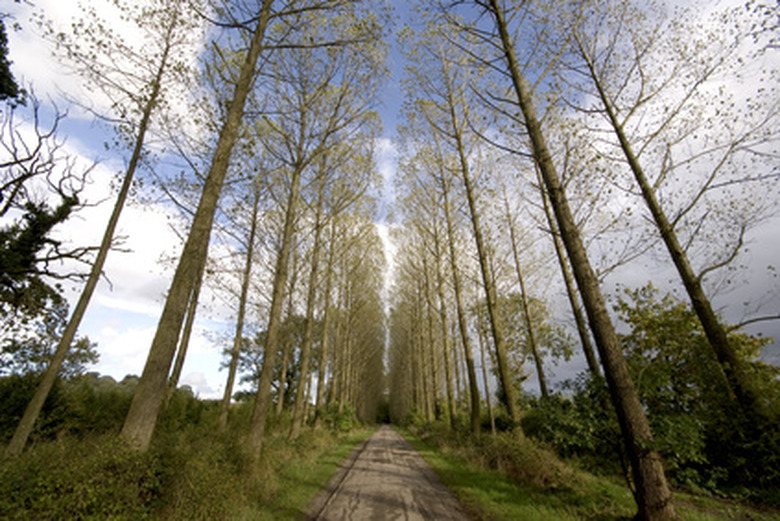Hybrid Poplar Planting Instructions
Things Needed
- Hybrid poplar tree
- Shovel
- Garden soil
- Mulch
The hybrid poplar (Populus spp.) is one of the fastest-growing trees available. Under the right conditions, it can reach 60 feet tall in as little as six years. Because of the enormous potential for creating wood products from the trees, new varieties now entering the marketplace are more disease and pest resistant. The tree adapts well in most areas of the United States, although hybrid poplars do not tolerate poorly drained soils that contain a large amount of clay. They prefer a soil pH of 5 to 7.5, which is considered average.
Step 1
Choose a location in the garden that receives full sun and has enough room for a large tree. Not only will the hybrid poplar tree grow tall quickly, it will have an eventual spread of about 30 feet if not crowded by other trees. The planting location should be near enough to a water source so the tree can receive supplemental water for the first year after it is planted. If the tree is grown in a container, it can be planted any time of the year. If the tree is bare root, it should be planted in fall or winter when the tree is dormant. A bare root tree with leaves on it planted in warm weather probably cannot survive because it was dug at the wrong time of the year.
- The hybrid poplar (Populus spp.)
- The planting location should be near enough to a water source so the tree can receive supplemental water for the first year after it is planted.
Step 2
Dig a hole three times the width of the root system of the hybrid poplar tree with the shovel. Break up and loosen any hard dirt. Hybrid poplar trees do not tolerate compacted, wet soil. Dig the hole deep enough to plant the tree at the same depth it is planted in the container. If the surface roots are exposed in the container, the tree can be planted up to 1-inch deeper than in the container. If planting a bare root hybrid poplar tree, look for a soil line at the base of the tree to see how deep it was previously planted and plant at that depth.
Step 3
Remove the tree from the container and set it into the planting hole. Arrange any roots encircling the root ball so do not continue to grow in a circle, but grow outwards. Refill the hole with the soil that was removed from the hole without adding any amendments or fertilizer. You want to the tree to quickly adapt to the native soil in your planting location. Add water to the soil as you refill the hole to create a sludge so the dirt works its way around the root system and no air pockets are formed.
- Dig a hole three times the width of the root system of the hybrid poplar tree with the shovel.
- Add water to the soil as you refill the hole to create a sludge so the dirt works its way around the root system and no air pockets are formed.
Step 4
Add a 2-inch layer of mulch around the bottom of the tree to conserve moisture and control weeds. Leave a 1-inch space between the mulch and the tree trunk so mildew and fungus cannot spread from the mulch to the young tree. Do not allow any weeds or grass to grow over the root base of the tree, or a distance of 18 inches, for the first two years, as grass pulls moisture away from the tree.
Tip
If there is no rain for a period of 10 days during the growing season, allow a stream of water from the water hose the width of a pencil to run over the root base of the tree for one hour. Repeat as often as necessary to keep the tree from wilting during the hottest part of the day. Do not over-water or water more than the recommended amount. Over-watering can drown the tree's roots by cutting off the oxygen supply.
Warning
Hybrid poplars have brittle limbs that often break during a wind storm, so plant the tree at least 50 feet from a building or other structure that could be damaged by falling limbs.
